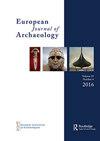实用的、视觉的还是仪式的?波兰东北部Bell Beaker地貌上的地面燧石箭头
IF 1.4
2区 历史学
0 ARCHAEOLOGY
引用次数: 0
摘要
在波兰东北部的Supraśl 3,Bell Beaker的四个特征中有少量烧焦且高度碎片化的人和动物骨骼,以及各种大多碎片化的人工制品。这些组合包括二十四个燧石箭头,其中大多数带有研磨痕迹,尽管并非所有箭头都经过相同程度的研磨。进行了全面的宏观和微观分析,以确定这些箭头的成型过程以及研磨它们的可能原因,特别是因为现场没有记录到当地的燧石加工。作者认为,磨制箭头既反映了实际问题,也反映了仪式问题,这可能源于对Rzucewo文化使用的技术的模仿,以及与更广泛的Bell Beaker环境的接触。本文章由计算机程序翻译,如有差异,请以英文原文为准。
Practical, Visual, or Ritual? Ground Flint Arrowheads from Bell Beaker Features in North-Eastern Poland
At Supraśl 3 in north-eastern Poland, four Bell Beaker features contained small quantities of burnt and highly fragmented human and animal bones and various, mostly fragmented, artefacts. These assemblages included twenty-four flint arrowheads, most of which bore traces of grinding, though not all were ground to the same extent. A comprehensive macroscopic and microscopic analysis was undertaken to determine the process of shaping these arrowheads and the possible reasons for grinding them, especially as no local flint working was recorded at the site. The authors suggest that the grinding of arrowheads reflects both practical and ritual concerns, possibly originating in emulation of techniques used by the Rzucewo culture and signalling contacts with the wider Bell Beaker milieu.
求助全文
通过发布文献求助,成功后即可免费获取论文全文。
去求助
来源期刊

European Journal of Archaeology
ARCHAEOLOGY-
CiteScore
3.40
自引率
6.70%
发文量
58
期刊介绍:
The publication organ of the European Association of Archaeologists, the European Journal of Archaeology seeks to promote open debate amongst archaeologists committed to a new idea of Europe in which there is more communication across national frontiers and more interest in interpretation. The journal accepts not only new empirical data and new interpretations of the past but also encourages debate about the role archaeology plays in society, how it should be organized in a changing Europe, and the ethics of archaeological practice. All periods are covered; papers, review articles, interviews and short "debate" pieces are all sought. Whilst English is the primary language of publication in the EJA, papers submitted in French or German will be given equal consideration.
 求助内容:
求助内容: 应助结果提醒方式:
应助结果提醒方式:


